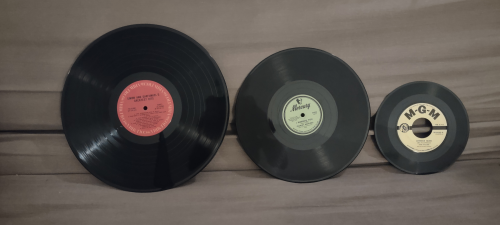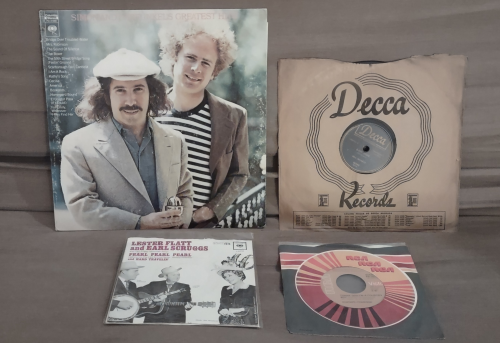Record Terminology
This page is to help people who don't know why I'm yakking off about 45s and 33s and 78s and 10" and 12" and 7". For friendly starters:
Vinyl ≠ Record!
These are not synonyms! What you see on my neocities is NOT a vinyl collection.
Record Materials
Record Materials:
- Vinyl: Vinyl records are made largely of Polyvinyl Chloride (PVC), a type of plastic. Vinyl is what records have been overwhelmingly made of since the second half of the Twentieth Century. This is why "vinyl" has been colloquially used as a synonym for records.
- Shellac: Shellac is a resin secreted from an insect. Shellac is the material largely used for records in the first half of the Twentieth Century. The majority of the records in my 78s collection are SHELLAC. They will be highly offended if you call them something they are not.
How to tell the materials apart?? Well, you’re probably not going to run into shellacs unless your family has a stash of real old records, you’re screwing around in a flea market where hell knows what you’ll find (highly recommend), or you got caught in the collection trap after saying “I’ll buy one for fun” then ended up like me. [cough] Anyway. Shellacs were phased out in the 1950s in the United States.
 |
← me attempting to photograph the textures of vinyl (left) vs. shellac (right) Vinyl is wibbly wobbly and a little bendy. Vinyl has a glossier, slicker texture than shellac. Shellac records are hard and stiff like dinner plates and that much more shatterable. Most shellacs are thicker.Shellacs have noisier, constant background noise. Vinyl in good condition will be near-silent with a rare, short crack here and there. |
| WARNING!! Before playing shellac records, be aware that they require different equipment! Shellac record grooves are wider, designed for a more elliptically-shaped needle. "RECORD CLEANER" is alcohol-based and used for vinyl, but will DISINTEGRATE SHELLAC GROOVES! PACKAGING RECORDS FOR SAFE TRANSPORT IS HUUUUGELY DIFFERENT PENDING on whether it's a vinyl album or a vintage shellac 78. Needles appropriate for these old records are purchasable for modern equipment. Spray bottles with water and a clean microfiber cloth are sufficient to maintain your shellacs. Shellac sellers describe their process of how to ship their fragile beasts. Do! 👏 your! 👏 research! 👏 before! 👏 you! 👏 destroy! 👏 shellac! |
Record Sizes
Record Sizes
- 12": The standard size for the stereotypical vinyl record of Today (TM). If you're buying an "LP" or an "album" today, chances are you're buying a 12" record.
- 10": The most common size of shellac records.
- 7": The size of most vinyl "singles."
While it's most common for 7" and 12" records to be vinyl and 10" records to be shellac, this is not always the case. 10" vinyl records exist. Similarly, 10" and 12" shellac records exist. Old shellac records could only store a few minutes of music. 10" records held a little over 3 minutes of music per side. 12" shellac records were sometimes provided for, say, classical music pieces; these could hold about 5 minutes of music per side.

↑ From left to right: 12″ 33 rpm vinyl; 10″ 78 rpm shellac; 7″ 45 rpm vinyl
Revolutions per Minute
Revolutions per Minute
Records come in different speeds - that is, how fast they rotate on the turntable. RPM stands for "revolutions per minute." When records were first invented, there was not a standardized rpm across record companies. This means records came in a variety of speeds. By the 1920s, most companies had settled to 78 rpm.
- 78 rpm: The standard rotation speed for shellac records from the 1920s to 1950s. These are the records that have only a few minutes of music per side.
- 45 rpm: The standard rotation speed for vinyl singles.
- 33 rpm: More accurately, 33 1/3 rpm, but it's frequently simplied to 33. The standard rotation speed for the stereotypical vinyl record of today, your everyday "LP" or "album."
Again, what I wrote is the most typical setup, but there is cross-pollination. When 78s were being phased out in the 1950s, some were being produced with vinyl as the material.
Older turntables usually designated 33 - 45 - 78 buttons to allow users to change revolution speeds. Newer turntables can lack the 78 option. However, there are decent modern turntables (don't buy budget!) that still provide all three.
Putting It All Together
Some shortcuts regarding material, size, and rpm: If you know just the material, size, or rpm of the disc, you can tend to predict what the other two variables are. It is not always the case, but these are the most common combinations:
10″ – Shellac – 78 rpm |
7″ – vinyl – 45 rpm |
12″ – vinyl – 33 rpm |
So, a 7″ record isn’t a true synonym for a 45 rpm record, but in quick speech the two might be co-assumed. These shortcuts will be used across my website (unless otherwise specified). When I say “a 78,” I mean a 78 rpm 10″ Shellac record that has about 3 minutes of music per side and was manufactured sometime between 1900 and 1958.
Since shellac records only had one song per side (the earliest were single-side!), a collection of records was put together in a binder, an album. This is where the phrase "record album" originated. When Long Playing (LP) records came into existence and they could put multiple songs per side, LP records also became known as "albums." And that's why your CDs you kids buy CDs, right? you should buy CDs. GET PHYSICAL COPIES TO OWN YOUR MEDIA!!!! release in "albums," too.
45s tend to be singles, more modern vinyl records that (in contrast to 33 rpm LP albums) have only one song per side. An Extended Play (EP) is halfway between a single and an album, with multiple songs per side, but not as many as an LP.
More Identification Strategies for Le Nerd
- Track Grooves: You can actually see the track grooves delineating separate tracks on LPs. It makes the record look like it has concentric circles like tree rings. Shellac 78s do not have this, ever.
- Holes: 45s have a big doughnut hole. Between their small size and their large doughnut hole, they are the doughnuttiest record offered on the market (don't eat them). Shellac 78s and your modern vinyl 33s have a smaller hole, like a puckered anus.
- Storage: LPs are sold in individualized covers and jackets. 45s may be sold in generic sleeves or individualized sleeves, but won't have the cardboard jacket covering and protecting them. 78s are sold in generic paper sleeves.
- Year Released: Commercial 33s began in 1948. Commercial 45s began in 1949. In the USA, shellac records faded out of production in the second half of the 1950s. Lots of records have dates on them. If it has a 1907 copyright on the record label, you better not call this freakin' thing an "LP."
- Labels: Not only will 78s labels look more old-timey, but they will clearly mark that there is only one song per side. 45s will also mark there is only one song per side. EPs and LPs will list off the songs on each side.

↑ Top left: 33 rpm LP in jacket. Top right: 78 rpm in its original sleeve. Bottom: 45 rpm records in individualized and generic sleeves